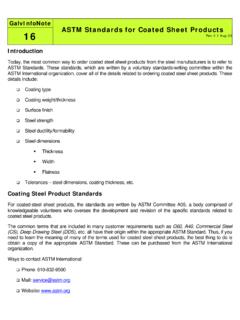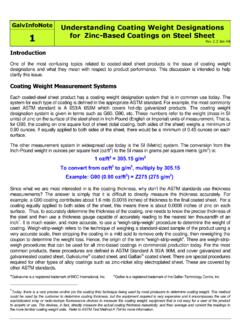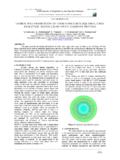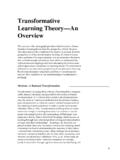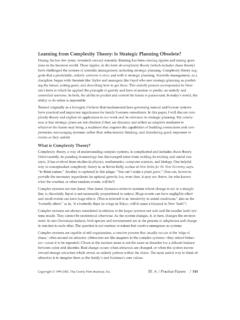Transcription of GalvInfoNote The Spangle on Hot-Dip Galvanized …
1 GalvInfo Center email: Toll-free phone: 1-888-880-8802 1 GalvInfoNote 13 The Spangle on Hot-Dip Galvanized Steel Sheet Rev Sep-03 Introduction For years, Galvanized articles made by Hot-Dip coating techniques were identified by the characteristic spangled appearance. In many cases, this is still true today. However, because of some changes in the manufacturing processes associated with zinc production and the galvanizing process, not all Hot-Dip Galvanized steel sheet made today has a visible Spangle . This explanation for this is given later in this GalvInfoNote . What is a Spangle ? The dictionary defines Spangle as a glittering object. When Spangle is used to define the surface appearance of Galvanized steel sheet, it includes the typical snowflake-like or six-fold star pattern that is visible to the unaided eye.
2 The following photograph shows the details of this pattern. This photograph shows the typical Spangle pattern of a Galvanized coating. The surface is magnified about 10X. The spangled structure of a Hot-Dip Galvanized coating. The features shown here encompass a number of quite complex metallurgical phenomena. In this GalvInfo Note, we will attempt to explain why these features are present. Note the 6-fold symmetry of this Spangle . Red arrow defines the direction of growth of the primary dendrite arm within the solidifying grain of zinc. Secondary dendrite arms growing laterally away from the primary arm. GalvInfoNote #13 Rev Sep-03 GalvInfo Center email: Toll-free phone: 1-888-880-8802 2 The Solidification Process First, one needs to understand that the development of spangles occurs when the molten zinc adhering to the steel sheet is cooled below the melting point of zinc.
3 The freezing point is approximately 419 C (787 F). At this temperature, the randomly-arranged atoms in the liquid zinc begin to position themselves into a very orderly arrangement. This occurs at many random locations within the molten zinc layer. This transformation from a disordered arrangement of the atoms into an orderly arrangement defines the solidification or crystallization process. The small solidifying areas within the molten zinc are defined as grains 1. As the individual atoms of molten zinc attach themselves to a solidifying grain (causing grain growth), they form into a distinct array, or crystal. In the case of zinc, the crystals form with hexagonal (six-fold) symmetry. It is this fundamental way in which the individual atoms of zinc arrange themselves as the solid zinc grains grow larger that leads to the often-visible hexagonal symmetry of the final Spangle .
4 When the coating is finally completely solidified, the individual spangles define specific individual grains of zinc. Nucleation is the term used to define the process of transformation of randomly arranged atoms of molten metal into a small, organized array of atoms in the seed crystals at the initial stage of solidification. A high rate of nucleation during the freezing process would tend to cause the formation of numerous small grains in the final solidified structure, while a low rate of nucleation would tend to favour the growth of large grains. Dendritic Growth There is another aspect of the solidification process that leads to the snowflake pattern in Galvanized coatings, viz., dendritic (meaning tree-shaped) growth. Dendritic growth causes the individual growing (solidifying) grains to grow into the melt (the molten zinc coating) with a distinct leading rounded edge.
5 A primary dendrite arm is identified in the photograph above. There are secondary dendrite arms that grow laterally away from the primary dendrite arms. Dendritic growth of grains during the solidifying of metals is very common. The reason that the dendrites are readily visible in a Galvanized coating is that we are basically seeing a two-dimensional version of an as-cast, dendritic, solidified grain structure. Remember, the coating is less than in (25 m) thick, considerably less than the diameter of a Spangle . In other metals (for instance in the steel substrate), the original as-cast, three-dimensional, dendritic structure of the grains is subsequently broken up into many smaller, more equiaxed grains. This is related to the effects of hot rolling (for example, rolling a 9-inch thick slab of steel into a thick steel sheet), cold rolling and recrystallization during the sheet-annealing process.
6 The rate of growth of the dendrite arms during the solidification of a Galvanized coating competes with the rate of nucleation of new grains within the molten zinc. This process determines the final size of the completely solidified structure. In the case of the above photograph, which is a Galvanized coating with a well-defined large Spangle pattern, the rate of dendrite growth dominated the solidification process leading to a small number of large spangles. One characteristic of such spangles is that they are thickest at their centers and thinnest at their edges, or grain boundaries. The grain boundaries can be said to be depressed and are difficult to smooth by subsequent temper passing. Dendritic growth is not the only way in which grains can grow during the solidification process. It requires one or more special conditions to be present.
7 One of these conditions is the presence of other elements in the molten metal. These can be either intentionally added alloying elements or impurities. In the case of Galvanized 1 Metals, like many solids in nature, have a grain structure. For example, the steel sheet beneath the Galvanized coating consists of many small grains of iron-carbon alloy (steel). The individual grains of steel are very small compared with the grains of zinc in the zinc coating, and these small steel grains are essentially glued to one another by atomic bonding forces. One can think of this as grains of sand in a sandstone rock . In the case of the sandstone rock, the size of the individual grains of sand are often larger than the grains in the steel sheet, but one can visualize the concept of grains using this analogy.
8 GalvInfoNote #13 Rev Sep-03 GalvInfo Center email: Toll-free phone: 1-888-880-8802 3 coatings on steel sheet, the most common reason for the well-defined dendritic growth pattern is the presence of lead in the coating. It has long been thought that the reason lead results in large spangles is that it has the effect of reducing the number of nucleation sites. In recent work1, it is proposed that that the presence of lead decreases the solid/liquid interfacial energy in the solidifying coating. This leads to an increase in dendrite growth velocity, resulting in large spangles. Lead precipitates at the coating surface and the varying distribution of lead particles across the surface define the optical appearance (dull vs.)
9 Shiny spangles). Lead is a common impurity in zinc. In years gone by, the most common form of zinc metal production involved smelting, distillation and condensation. Lead is a common metal found in zinc-containing ores, and this refining process carried it through as an impurity in the zinc. Therefore, in the early days of galvanizing, lead was almost always present in the zinc, and it was common to see the Spangle pattern. Galvanized coatings on steel became identified by the characteristic Spangle . Essentially, all Hot-Dip Galvanized coatings had a spangled appearance. If the Spangle wasn t visible, the users knew that the steel had not been Galvanized . The first Galvanized coatings contained as much as 1% lead. During the past 25 years, the presence of such high lead levels has not been common in the Galvanized coatings on steel sheet, at least not in North America, Europe, and Japan.
10 Typical concentrations of lead in most Galvanized sheet made during the past 25 years are less than , often as low as to However, this amount of lead is still sufficient to develop dendritic growth behaviour during the solidification process. Today, a typical level of lead in the coating bath on lines where the primary product has a well-developed Spangle pattern is in the range of to lead. Non-Spangled Coatings In recent times, the production of zinc from zinc-containing ores has been changed to an electrolytic recovery method. In this method of zinc production, the refined zinc is very pure, with the lead being excluded. This change occurred at a time when many users of Galvanized sheet, especially those desiring a high quality finish after painting, such as the automotive and appliance industries, needed a non-spangled coating.





